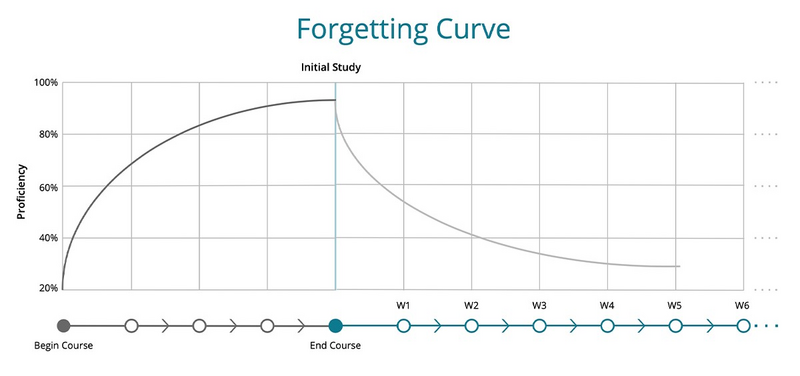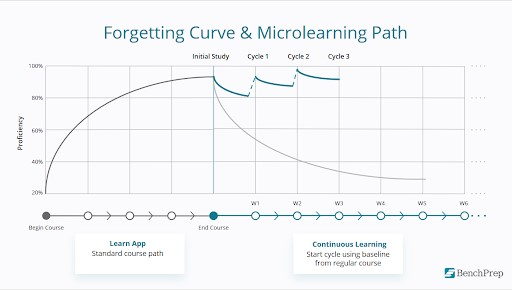Professional Partner Content
Two Continuous Learning Strategies That Will Make Your Training Program Unforgettable
Published Thu Feb 04 2021
Picture this: A learner is preparing for a high-stakes exam, earning a credential, or getting a certification. They attend your online classes, read the necessary study materials, and take practice exams. The night before the test, they cram for hours.
All their hard work pays off when they pass the exam, earn the credential, or achieve their certification.
But, if your learner is like most people, they immediately begin to forget what they learned due to what is known as the forgetting curve, which shows that after just 30 days, learners forget 79 percent of what they
learned.
The best education and training programs don’t just help learners obtain knowledge. For the best outcomes, your learners must also retain what they’ve learned. To accomplish this, you need to incorporate continuous learning strategies within your training programs.
How the Forgetting Curve Works
The forgetting curve illustrates an important fact about human memory—the human brain needs to use and retrieve information to commit it to memory. If learners don’t continuously apply new knowledge or review it, they’re likely to fall victim to the forgetting curve.

This chart shows a traditional learning pathway in a transactional, point-in-time learning program. We can see the regression and deterioration of recall without reinforcement thanks to the forgetting curve.
This can be tricky for training organizations because they need to ensure their learners are continuously learning after they’ve completed the program. The forgetting curve works against the goals of learning programs because once learners complete an exam, they have little motivation to revisit online courses. In fact, BenchPrep data shows that learners average 98 percent fewer sessions in an online learning platform after they complete their study plan.
Those who work in training and development need to focus on helping learners prepare for an exam, earn a credential, or complete a training as well as invest in their mastery beyond the exam. Luckily for us, are two continuous learning strategies that can help: spaced repetition and microlearning.
How Microlearning and Spaced Repetition Can Help Combat the Forgetting Curve
Digital transformation has made our attention spans narrow. There’s an abundance of information available to us, and we’ve grown used to changing tasks and quickly switching gears. Short attention spans are a major threat to the success of training programs, so it’s more important than ever to deliver learning and education in byte-size chunks that fit the needs of the modern learner.
Microlearning presents information in two- to 10-minute chunks based on one objective. Of course, microlearning will help your learners leading up to the exam, but it is equally important post-exam to help them retain the information they learned. And when you pair microlearning with spaced repetition, your programs become even more powerful at boosting your learners’ knowledge retention.

In the chart above, you can see what can be achieved through microlearning and spaced repetition. By reintroducing content in small intervals over time, you slow down the forgetting curve while significantly increasing the chances of knowledge being committed to long-term memory.
You may be familiar with a popular study method known as flashcards, but you may not know what makes them so powerful in helping your learners attain and retain knowledge. Flashcards work because of spaced repetition.
Flashcards are just one example of how to bring spaced repetition to your training program. You can also embrace spaced repetition by structuring your courses in a way that exposes your learners to the same content in different formats throughout the learning experience: a lesson, an overview module, a quiz question, a game, and review can all draw from the same key concept to reinforce your learning.
To help combat the forgetting curve, your training programs should deliver content over spaced intervals of time. By reintroducing content in small intervals (microlearning) over time (spaced repetition), you slow down the forgetting curve and increase the chances of knowledge being committed to long-term memory.
To learn about the relationship between continued learning strategies and building sustainable revenue streams, download the e-book Dreaming of Recurring Revenue? Engage Learners Continuously.
You've Reached ATD Member-only Content
Become an ATD member to continue
Already a member?Sign In

